India :Taj Mahal: one of the seven wonders of the world
India: Taj Mahal: one of the seven wonders of the world
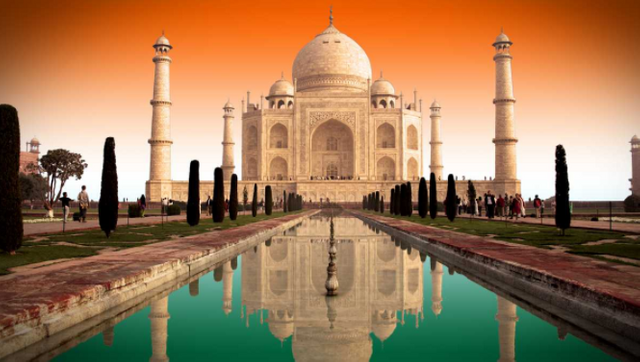
Location: Agra & Uttar Pradesh, India
Date of official opening: 1652
Height:240 foot
Commissioned by: Shah Jahan
Type of architecture: Mughal
Architect: Ustad Ahmad Lahauri
The name means: Crown of Palaces
Cost: 32 million rupees, which in 2015 would be 52.8 billion rupees or 827 million U.S. Dollars.
Features: The 42-acre complex, which includes a mosque, a tomb and a guest house, and is set in formal gardens bounded on three sides by a crenellated wall. The ivory-white marble mausoleum on the south bank of the Yamuna river in the India.
Honors: UNESCO World Heritage Site
The Shah Jahan and favorite wife Arjumand Banu Begum better known as Mumtaz Mahal (“Chosen One of the Palace”).
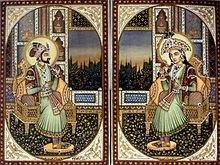
The Shah Jahan
Shah Jahan was widely considered to be the most competent of Emperor Jahangir's four sons and after Jahangir's death in late 1627, when a war of succession ensued, Shah Jahan emerged victorious. He put to death all of his rivals for the throne and crowned himself emperor in January 1628 in Agra under the title "Shah Jahan". Although he was a good military commander, Shah Jahan is best remembered for his architectural achievements. His reign is considered to be the golden age of Mughal architecture. Shah Jahan commissioned many monuments, the best known of which is the Taj Mahal in Agra, which entombs his beloved wife Mumtaz Mahal.
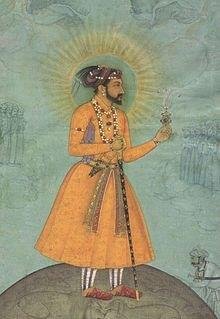
The favorite wife of the Shah was Arjumand Banu Begum, better known as Mumtaz Mahal (“Chosen One of the Palace”), whom he married in 1612 and cherished as the favorite of his three queens. In 1631, Mumtaz Mahal died after giving birth to the couple’s 14th child. The grieving Shah Jahan, known for commissioning a number of impressive structures throughout his reign, ordered the building of a magnificent mausoleum across the Yamuna River from his own royal palace at Agra.
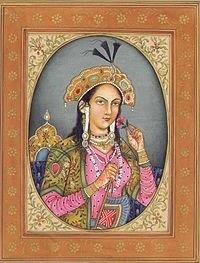
The Taj Mahal
The Taj Mahal attracts from 7 to 8 million visitors annually, with more than 0.8 million from overseas. Most tourists visit in the cooler months of October, November and February. Polluting traffic is not allowed near the complex and tourists must either walk from parking lots or catch an electric bus. The overall composition is formed of two major components: the mausoleum and its garden, and two subsidiary courtyard complexes to the south. The central focus of the complex is the tomb. This large, white marble structure stands on a square plinth and consists of a symmetrical building with an iwan (an arch-shaped doorway) topped by a large dome. Construction began around 1632 and would continue for the next two decades. The chief architect was probably Ustad Ahmad Lahouri, an Indian of Persian descent who would later be credited with designing the Red Fort at Delhi.
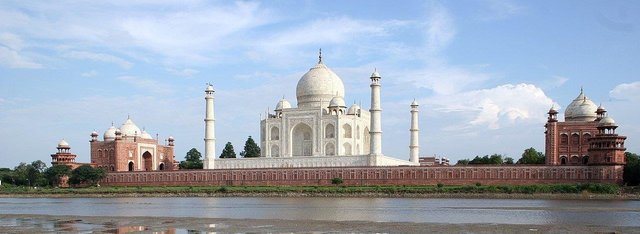
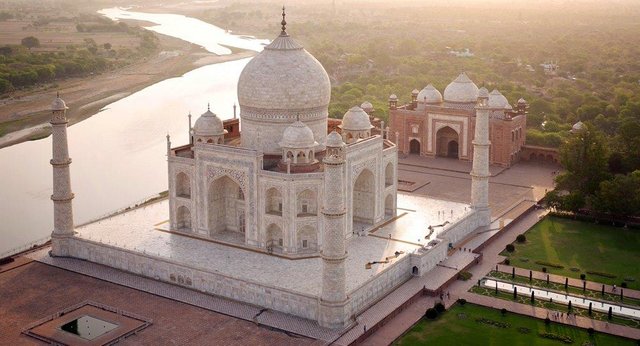
The Mausoleum
Also known as Rauza-i-Munauwara or Rauza-i-Muqqadas or Rauza-i-Mutahhara. The mausoleum dominates the entire Taj complex: the grand white marble building. The mausoleum is set at the northern end of the main axis of vast oblong walled complex which descends in hardly noticeable terraced steps towards the river Yamuna. The tomb is at the northern end with an expanse of greenery and fountains between it and the gateways. Like most Mughal tombs, the basic elements are Persian in origin. The base structure is essentially a large, multi-chambered cube with chamfered corners, forming an unequal octagon that is approximately 180 feet on each of the four long sides.. Four minarets frame the tomb, one at each corner of the plinth facing the chamfered corners. The main chamber houses the false sarcophagi of Mumtaz Mahal and Shah Jahan; the actual graves are at a lower level.
The tomb laid out in rectangular shape can be approached through an immense gateway with huge arch and alcoves strewn on either side that stands tall and erect, as though guarding something precious. The calligraphy on the Great Gate reads "O Soul, thou art at rest. Return to the Lord at peace with Him, and He at peace with you." Three other smaller gateways follow the red sandstone towers topped with domes in white marble together make a pretty picture. The marble dome that surmounts the tomb is the most spectacular feature is accentuated as it sits on a cylindrical "drum" which is roughly 23 feet high. Because of its shape, the dome is often called an onion dome.
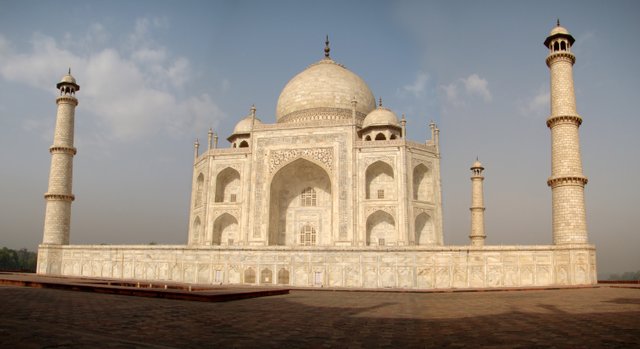
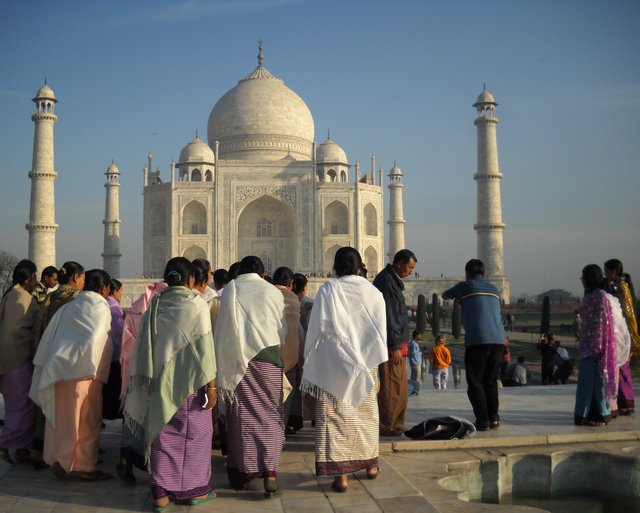
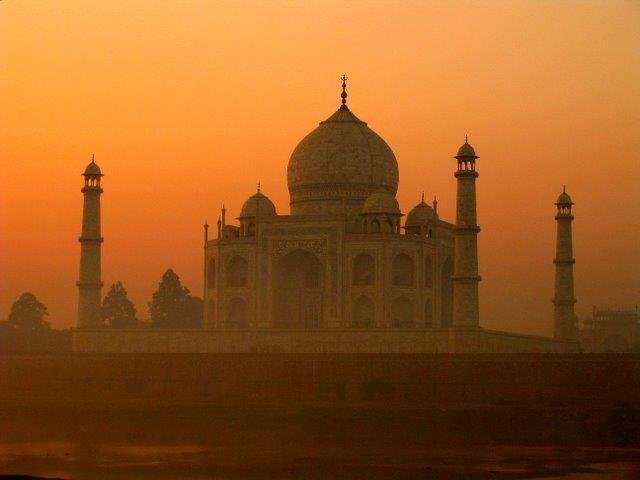
The Mughal Gardens
The terrace of the Taj Mahal is the most ambitious ever built in a Mughal riverfront garden scheme, unprecedented in size and decoration and one of the most impressive platforms in the history of architecture. Its full splendor is displayed towards the river, where it forms an uninterrupted red sandstone band 28 feet 6 inches high from the lowest visible plinth and 984 feet long, with elaborate decoration in relief and inlay work. The riverfront terrace was the first part of the Taj Mahal complex to be built. All the areas are differentiated by their paving in varying geometrical patterns of dark and light sandstone.
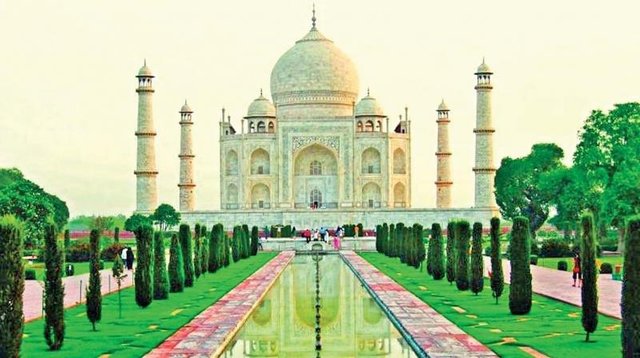
The favorite wife of the Shah was Arjumand Banu Begum, better known as Mumtaz Mahal (“Chosen One of the Palace”), Photo courtesy of the India Department of Tourism
was born 6th April 1594 and was married to Prince Khurram (Shah Jahan). Their marriage took place in April 1612. The marriage of Shah Jahan and Mumtaz Mahal proved to be very successful. Arjumand Banu Begam captivated Shah Jahan’s heart even more than Nur Jahan had done to that of Jahangir. Arjumand Banu Begum shared Shah Jahan’s joys and sorrows in full measure and behaved like a devoted wife during her husband’s flight from the Deccan to Orissa, Bengal and Bihar in the course of his rebellion against his father. She bore 14 out of her husband’s 18 children and remained his friend and inseparable companion till her death.
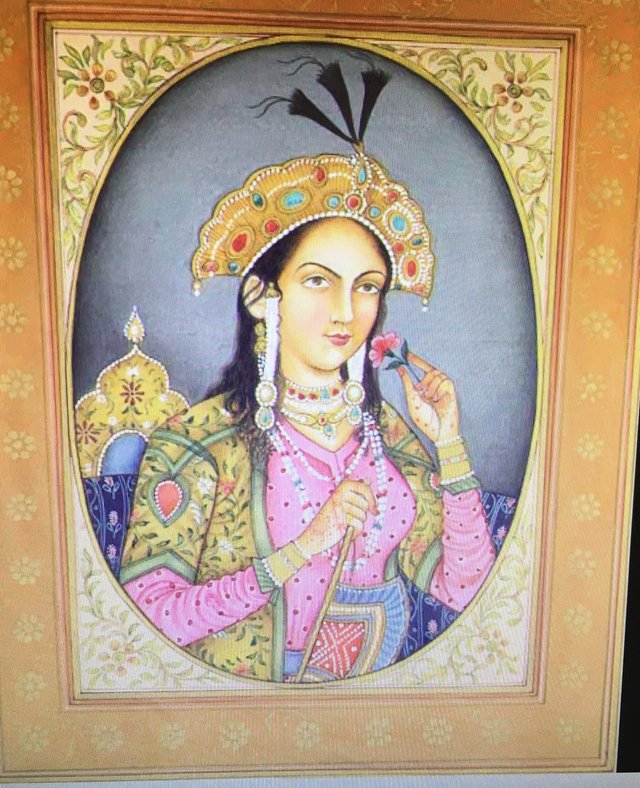
Photos
All photos are from public domain courtesy of the India Department of Tourism and other public sources.
References
- Wilkipedia
- Encyclopedia Britanica
- The English Encyclopedia
- Historical articles on the history of India in the public domain
- India Department of Tourism website
India truly is full of many wonders. You really did a nice job here combining beautiful pictures with a nice narrative. You gave the basic facts and then developed the human side of the story. The pictures of the couple makes them both much more human. This is the first article I have read which actually showed the favorite wife and told a little about her. I was amazed that she gave birth to 14 children! The Taj Mahal is beautiful and your brief article was much better then I expected on Steemit. I hope the community responds so that you continue to do articles on this great and historic country.
Go here https://steemit.com/@a-a-a to get your post resteemed to over 72,000 followers.
This is very interesting. India is a great country filled with great man made wonders!
I agree this is another contribution to the worlds great cultural heritage from India.
I really appreciate learning a little about this Indian ruler and his wife, while enjoying some very good pictures of the Taj Mahal, one of the great wonders of the world.
Thanks for showing the world great things in India!
you are my old service user and give you this upvote free ( when i came back i inform you )
You got a 2.81% upvote from @emperorofnaps courtesy of @lalai!
Want to promote your posts too? Send 0.05+ SBD or STEEM to @emperorofnaps to receive a share of a full upvote every 2.4 hours...Then go relax and take a nap!